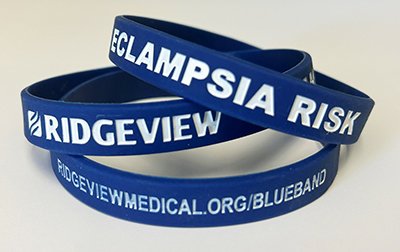Preeclampsia
Preeclampsia is a serious disorder that can affect many organs (brain, kidneys, and/or liver) in your body. When preeclampsia occurs, it is usually during the last half of pregnancy, most often after 20 weeks. It can also occur up to six weeks after the baby is born.
Preeclampsia can cause:
- High blood pressure
- Protein in the urine
- Organ damage
- Eclampsia (seizure), which can lead to stroke and/or death
Signs and symptoms:
- Swelling of face or hands
- Headache that is severe or will not go away
- Seeing spots or changes in vision
- Pain in the upper right area of the abdomen (belly)
- Sudden or rapid weight gain
- Shortness of breath, confusion or anxiety
- Heartburn that will not go away
- Decreased urination
- High blood pressure
- Chest pain
If you notice any symptoms of preeclampsia you should seek medical attention. If you have questions or are unsure if your symptoms may require medical attention, please call the Birthing Center at 952-777-4646.
Risk factors:
- History of high blood pressure
- First pregnancy
- Preeclampsia in a previous pregnancy
- Family history of preeclampsia
- History of kidney disease
- 35 years or older
- Carrying more than one baby
- Certain medical conditions such as diabetes, bleeding disorders, or certain auto-immune conditions
- Fertility treatments
Risks for baby if preeclampsia occurs:
- Premature delivery
- Stillbirth
Long-term risks of preeclampsia:
Preeclampsia can cause serious health problems and could have lifelong impacts. Women who have had preeclampsia have increased risk of heart disease, heart attack and stroke, and high blood pressure.
Blue Band Project

Ridgeview participates in the Blue Band Project, an initiative in partnership with the Minnesota Perinatal Quality Collaborative (MNPQC), aimed at immediately making health care professionals aware of a patient’s diagnosis of or risk for eclampsia (seizures) when the patient is seeking medical care for symptoms or concerns.
Patients who are at risk of or have been diagnosed with preeclampsia or have high blood pressure are offered a blue band to wear throughout pregnancy and up to six weeks after they deliver their baby. The blue bands alert health care professionals that the patient is at risk of eclampsia, which is a life-threatening condition.
Wearing a Blue Band
If you have been given a blue band you are at risk of developing eclampsia (seizures).
You should:
- Leave the blue wristband on until your health care provider takes it off or tells you that you can take it off
- Keep your follow-up appointments with your health care provider, even if you are feeling well
- Expect your first follow-up appointment after delivery to be within two to five days of discharge from the hospital
- Continue your prescribed medications as directed
It is important to let health care providers know if you are pregnant or have recently been pregnant.
Many complications of preeclampsia can be prevented. MNPQC is working to raise awareness of preeclampsia in our communities by using the blue medical alert bands.